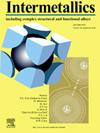在具有 BCC 和 FCC 晶体的 Al5Co21Fe21Mn17Ni36 高熵合金中实现超高强度和良好延展性
IF 4.3
2区 材料科学
Q2 CHEMISTRY, PHYSICAL
引用次数: 0
摘要
设计了一种由 FCC 相和 B2 相组成的非等摩尔比 Al5Co21Fe21Mn17Ni36 HEA。该材料在 -196 ℃ 时达到了超高屈服强度和极限抗拉强度,分别为 1100 ± 5 兆帕和 1500 ± 10 兆帕,同时还保持了 15% 的可观延展性。在拉伸测试过程中,由于纳米级 B2 粒子的存在,随着温度从 25 ℃ 降到 -196 ℃,位错的滑移模式从交叉滑移转变为平面滑移。尤其是在 -196 °C时,平面滑移因堆叠断层能的降低而得到促进,从而有效地促进了位错在B2相周围的聚集。本文章由计算机程序翻译,如有差异,请以英文原文为准。
Achieving ultrahigh strength and good ductility in a Al5Co21Fe21Mn17Ni36 high-entropy alloy with BCC and FCC crystals
A non-equimolar ratio Al5Co21Fe21Mn17Ni36 HEA is designed, composed of FCC and B2 phases. The ultrahigh yield strength and ultimate tensile strength are achieved at −196 °C, reaching 1100 ± 5 MPa and 1500 ± 10 MPa, respectively, while retaining a considerable ductility of 15 %. During tensile testing, the slip mode of dislocations shifts from cross-slip to planar slip with decreasing temperature from 25 °C to −196 °C due to the nanosized B2 particles. In particular, planar slip is promoted by reducing stacking fault energy at −196 °C, thus effectively promoting the dislocation accumulations around the B2 phase.
求助全文
通过发布文献求助,成功后即可免费获取论文全文。
去求助
来源期刊

Intermetallics
工程技术-材料科学:综合
CiteScore
7.80
自引率
9.10%
发文量
291
审稿时长
37 days
期刊介绍:
This journal is a platform for publishing innovative research and overviews for advancing our understanding of the structure, property, and functionality of complex metallic alloys, including intermetallics, metallic glasses, and high entropy alloys.
The journal reports the science and engineering of metallic materials in the following aspects:
Theories and experiments which address the relationship between property and structure in all length scales.
Physical modeling and numerical simulations which provide a comprehensive understanding of experimental observations.
Stimulated methodologies to characterize the structure and chemistry of materials that correlate the properties.
Technological applications resulting from the understanding of property-structure relationship in materials.
Novel and cutting-edge results warranting rapid communication.
The journal also publishes special issues on selected topics and overviews by invitation only.
 求助内容:
求助内容: 应助结果提醒方式:
应助结果提醒方式:


